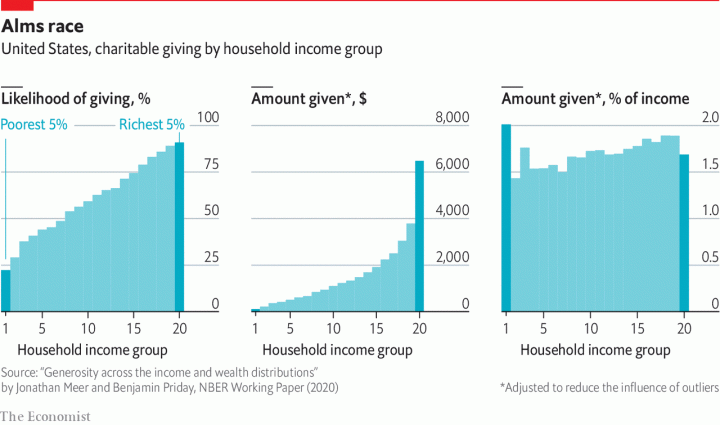 Giving to charity has the double taboo of being both about money and your generosity to others. Double the chance for judgment, at least!
Giving to charity has the double taboo of being both about money and your generosity to others. Double the chance for judgment, at least!
“And once again, tithing is 10 percent off the top, that’s gross income, not net. Please people, don’t force us to audit.” -Rev. Lovejoy, The Simpsons
How much do people really give to charity? Since nobody talks about it, I had no idea until I read this NBER paper Generosity Across the Income and Wealth Distributions by Meer and Priday. The authors examined the Panel Study of Income Dynamics, the “longest running longitudinal household survey in the world” with data from over 10,000 US households between 2001 and 2017. This Economist article summarized the results into a nice chart (click to enlarge):
The general conclusions:
- The higher the income, the more likely you are to donate at all.
- The higher the income, the higher the amount given (total dollars).
- The higher the income, the amount given as a proportion of income (percentage) tends to stay roughly the same.
People across all income levels gave between 1% and 2% of their incomes to charity on average, after adjusting for effect of outliers. This is not to say that this number is the “right” amount to give for any specific household. The paper argues that previous studies which found lower-income households gave a higher percentage than higher-income households were skewed due to outliers (older households with temporarily low incomes but high net worth), and so they used the statistical method of “windsoring” to adjust for extreme outliers.
Found via Abnormal Returns and Benningfield Advisors.

 The Best Credit Card Bonus Offers – 2025
The Best Credit Card Bonus Offers – 2025 Big List of Free Stocks from Brokerage Apps
Big List of Free Stocks from Brokerage Apps Best Interest Rates on Cash - 2025
Best Interest Rates on Cash - 2025 Free Credit Scores x 3 + Free Credit Monitoring
Free Credit Scores x 3 + Free Credit Monitoring Best No Fee 0% APR Balance Transfer Offers
Best No Fee 0% APR Balance Transfer Offers Little-Known Cellular Data Plans That Can Save Big Money
Little-Known Cellular Data Plans That Can Save Big Money How To Haggle Your Cable or Direct TV Bill
How To Haggle Your Cable or Direct TV Bill Big List of Free Consumer Data Reports (Credit, Rent, Work)
Big List of Free Consumer Data Reports (Credit, Rent, Work)
Speak Your Mind